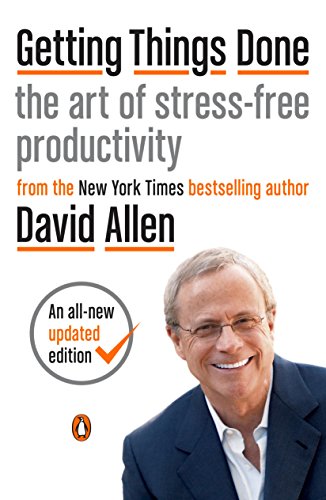

This article is an excerpt from the Shortform summary of "Getting Things Done" by David Allen. Shortform has the world's best summaries of books you should be reading.
Like this article? Sign up for a free trial here .
What is the art of stress-free productivity? And how can you achieve it?
The art of stress-free productivity is addressed in the Getting Things Done system. A modern way of organizing, the Getting Things Done system not only helps you stay organized, but teaches the art of stress-free productivity.
Psychological Capital and the Art of Stress-Free Productivity
When you’re trying to achieve the art of stress-free productivity, there’s a lot to take into consideration. It involves your well-being as well as that of your employees.
Psychological capital (PsyCap) is a framework for measuring workers’ effectiveness and psychological well-being.
There are four components of PsyCap, and the GTD system promotes each of them:
1) Self-efficacy (as we mentioned above) is the confidence that you can tackle and succeed at a task.
The GTD practice of capturing and clarifying all your open loops creates a complete picture of your commitments and next actions. Seeing all this in front of you gives you confidence that you know what you need to do and how to do it.
2) Optimism is your positive feeling about your ability to succeed now and in the future.
The GTD system helps you track your progress on projects and actions, and every step forward you make gives you a psychological “win” that boosts your motivation and confidence in your future success.
3) Hope is your ability to work toward your goals, even when it means redirecting your paths to get there.
The GTD program emphasizes front-end decision-making by forcing you to identify projects and clarify next actions. This practice involves setting goals (identifying projects) and determining the paths to achieving them (clarifying next actions).
4) Resilience is your ability to bounce back and persevere after encountering problems.
The GTD system aims to give you a sense of stress-free control over your life, and when you feel like you have a handle on everything in front of you you’ll be able to face challenges with more calm and clarity.
Engaging in Stress-Free Productivity
It’s the moment of truth: You have a half-hour free in your schedule. What do you do?
The simple answer is to trust your intuition. But with so many tasks pulling at you from different areas of your life, that’s easier said than done.
Let’s dive deeper into the three frameworks for prioritizing affects the art of stress-free productivity.
The Four Criteria Model for Narrowing Down Your Options
Begin by narrowing down your options using the following four criteria. This will guide you to the best way to spend your time while working on the art of stress-free productivity.
Criteria #1: Context
Consider the context. If you’ve divided your next actions into categories—such as Calls to Make and Computer Tasks—then you can easily pull up the list that applies to where you are and what tools you have available. Categorized lists save you the time and brain power it takes to scan through a master Next Actions list and determine which tasks you can tackle in a given context.
You can be creative with the categories of your action lists, such as creating a “Brain Gone” list for mindless tasks and a “Less Than 5-Minute” list for quick tasks. You can also make time-sensitive lists and group everything you need to accomplish before a certain deadline—for example, before you leave for a trip—into one list.
You might not need to get this specific when you’re starting out with the Getting Things Done system, but as time goes on create new lists based on what works for you.
Criteria #2: Time
How much time do you have? If you have only 15 minutes before your next appointment, don’t dive into something that’s going to take an hour to accomplish.
Narrowing your options to fit the time you have maximizes your productivity by making use of odd windows of time in your day, for instance while you’re on hold on the phone, waiting for a meeting to start, or sitting in the waiting room at your doctor’s office.
Criteria #3: Energy
You have only so much physical energy and brainpower, so be realistic about your energy level and choose an action that matches. If you’re working on something mentally demanding, you’ll eventually reach a point of diminishing returns; although you might be able to push through, you’re not going to get the most productivity for your time and effort.
Instead, switch to a task that requires less effort, like calling your sister about her visit or changing your flight reservation (pull out your “Brain Gone” list). This is a great way to continue being productive while still giving your brain a rest—you’ll feel more accomplished (and perhaps energized) than if you’d stepped away from everything.
Criteria #4: Priority
Once you’ve narrowed down your options, the big question is: What’s the biggest priority? There’s no objective answer to this question because it factors in your various roles, responsibilities, goals, and values.
In order to prioritize, consider what category of work a task falls into, which we’ll explore in the next model, as well as your six horizons, which we’ll talk about in the following model.
The Threefold Model for Evaluating Your Work
Both this model and the one mentioned above will help you learn the art of stress-free productivity. Think of everything you have to do in both the personal and professional areas of your life as “work.” Given that context, you face three different types of work on any given day:
- Predefined work: This is the actions you’ve already captured, clarified, and organized onto your action lists and calendar. You’ve already deemed these important, so make them a high priority.
- Work that shows up: This is the work that comes up unexpectedly throughout the day—when your boss walks into your office and asks for a few minutes to chat or you get in your car and see the oil change light is on. Prioritize these tasks when they’re more important than your predefined work; otherwise, put them in your in-tray.
- Defining your work: This is the time you spend clarifying and processing everything in your in-tray and organizing it into the appropriate places. Prioritize time to do this during your Weekly Review.
People often prioritize work that shows up by default, just doing what’s in front of them and seemingly urgent. But that approach leaves them feeling behind, not in control, and bothered by every interruption.
By contrast, if you regularly invest time in defining your work and have an organized system of predefined work, you can make well-informed choices about which task to engage in at any time. This benefit plays out in a few ways:
- When work that shows up is truly urgent and must be addressed immediately, you’re aware of the predefined work that you’re delaying. This puts you in a better position to make specific plans to still get everything done on time, as opposed to feeling frustrated and anxious because you only have a general sense that there are other things you need to be doing.
- Having a reliable system for intaking, defining, and organizing work gives you peace of mind that you can put a hold on what you’re doing to deal with the work that shows up and easily come back to it later, or that you can put the work that shows up in your in-tray and know that you’ll get it done on time.
- Being aware of the items on your calendar and action list prevents you from overlooking or neglecting items until they “show up” as emergencies when their deadlines arrive.
The Six-Level Model of Prioritizing
Finally, prioritizing. You know your tasks. Now you need to achieve stress-free productivity. We’ve talked about frameworks to weigh out the tasks in front of you. It’s also critical that you keep your commitments and work in balance with your bigger-picture goals, values, and responsibilities. If your boss asks you to chair a committee at work, it may seem important until you stop and consider whether devoting your time and energy to that helps you achieve your professional goals.
Think of this model as a six-story building: The ground floor deals with the daily grind while the top floor gives you the best view into the distance.
- Ground is current actions
- Horizon 1 is current projects
- Horizon 2 is your roles and responsibilities
- Horizon 3 is your short-term (one- to two-year) goals
- Horizon 4 is your long-term goals
- Horizon 5 is your life purpose and guiding principles
In order to keep your ground floor in line with your highest horizons, consider this example:
- Action (Ground): You have a phone call to make for work.
- Project (Horizon 1): The call is about a deal you’re trying to make.
- Responsibility (Horizon 2): This deal would increase the company’s sales.
- Short-term goal (Horizon 3): Making the deal would earn you major points with your boss.
- Long-term goal (Horizon 4): This success would likely lead to a promotion.
- Life (Horizon 5): A promotion will put you in a position that allows you to have the career and lifestyle you want.
When you know that your relatively small to-do is helping you move in the direction you ultimately want to go in life, it helps you stay motivated, productive, and stress free. By contrast, when you feel like you’re spinning your wheels and spending your time on tasks that don’t benefit you, it is stressful, frustrating, and anxiety-inducing.
Work From the Bottom Up
It might seem logical to determine your priorities from the top-down—decide your life purpose, use that to define your goals, create or commit to responsibilities that move you toward those goals, and then identify projects and actions within those responsibilities. However, in practice, it’s more realistic to work from the bottom-up because getting in control of the actions in front of you frees up your mind to think about projects, which leads to higher thinking about your responsibilities, and so on. This can help you work on stress-free productivity.
(Shortform note: This is similar to the principle behind psychologist Abraham Maslow’s hierarchy of needs, which states you can’t attend to your higher-level needs—including a sense of belonging and self-esteem—until you’ve met your basic needs for food, water, shelter, and safety.)
Follow these guidelines to work through everything from the bottom-up:
- Ground: Keep your action lists complete and current so you’re grounded in the knowledge of your immediate tasks.
- Horizon 1: Keep your Projects list complete (review the tips in Chapter 7 for identifying hidden projects). This gives you a snapshot of your workload and helps you make decisions week to week.
- Horizon 2: Make a checklist of your various roles (for example, parent, manager, activist, individual) and consider making sublists with your responsibilities associated with each role. You don’t need to review these checklists weekly, but review them regularly and look out for potential projects to improve within your roles and responsibilities.
- Horizons 3-5: While the first few horizons deal with the present, the higher horizons deal with your future, including career planning, business strategy, and life direction. Assessing these horizons will be a more personal, introspective process in which you might as yourself:
- What are your long-term professional goals, and what current projects work toward those goals?
- What are your long-term personal goals, and what current projects work toward those goals?
- Are there any major changes (in your company, family, or life in general) that may impact your options or desires in the future?
Mastering the art of stress-free productivity takes a lot of practice and patience. But with the Getting Things Done system, the art of stress-free productivity can be within reach.

———End of Preview———
Like what you just read? Read the rest of the world's best summary of David Allen's "Getting Things Done" at Shortform .
Here's what you'll find in our full Getting Things Done summary :
- Why you're disorganized and your to-do list is a mess
- The simple workflow you can do everyday to be more productive than ever
- How to take complicated projects and simplify them






